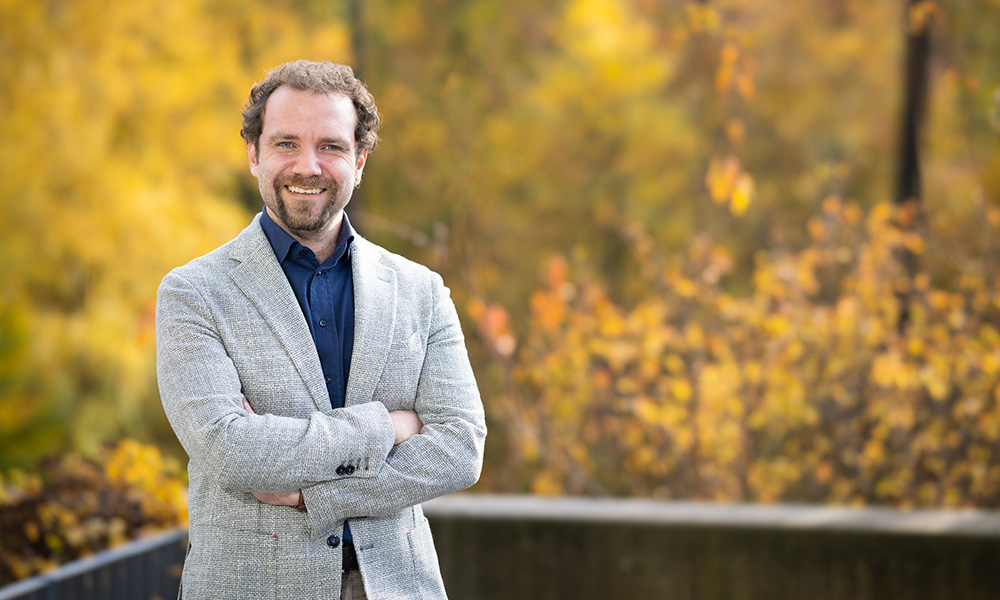
Welcome: Niccolò Banterle
New group leader deciphers the challenging, yet ‘beautiful’ structure of centrioles at different scales to understand their functions

Abandoning his childhood dream of becoming a wizard, Niccolò Banterle, one of EMBL’s newest group leaders, has instead tapped science and technology to better understand centrioles – subcellular structures consisting of various proteins. Here, he shares a little bit about his research, why centrioles are so beautiful, and why EMBL’s strength in imaging and multidisciplinary culture are the right environment for his scientific endeavours.
1. Tell us about your research.
During my PhD, I worked on nuclear pore complexes that allow small molecules and ions to freely pass in and out of the nucleus. Then, during my postdoc, I studied centrioles – organelles that organise microtubules and are important in many cell functions, including cell division, motility, and signalling. While we’ve experienced major advances in understanding the structures, molecular compositions, and assembly principles of both of these important protein complexes, we don’t know why evolution selected these particular ultrastructures to do the jobs they do.
For example, the centrioles of all animals have a 9-fold symmetry. However, we don’t yet know why, although it seems that this symmetry has an impact on the cell structures involved in motility. We also don’t know why centriole length is tightly controlled within each cell type but varies greatly between different species, and this may have functional relevance. Centriole structure is very small – about ~500 nanometres, while the many important functions it performs (e.g., cell division, signalling, motility) happen on a bigger, cellular scale (~100 micrometres). So, we need a multi-scale model that links this range and we also need the necessary retro-engineering to decipher the design principles of macromolecular assemblies and their impact on cellular functions.
In my lab, I want to perturb three parameters of centriole structure – symmetry, distance, and length – and then measure the effect of these changes at different scales using high-speed atomic force microscopy, super-resolution microscopy, and live cell imaging. This way, my group and I can establish how organelle ultrastructure controls physiological cell function and choose the best scale to intervene and then control it.
2. You’ve described centrioles as beautiful organelles. What makes them so pretty?
I guess beauty is in the eye of the beholder. That said, I think the combination of an odd symmetry and their chiral nature makes centrioles more similar to what we might expect in an art gallery than some other less ordered cellular structures.
3. What previously limited studies on centrioles, and why can we study them better now?
What makes centrioles difficult to study is their size. It is impossible to resolve their features with conventional optical microscopy. We now can combine techniques: CRISPR-Cas9 allows for gene editing with unprecedented precision. Cryo-electron microscopy makes it possible to visualise the unaltered structure of centrioles. Super-resolution microscopy localises individual proteins within the organelle ultrastructure. Finally, high-speed atomic force microscopy can extract dynamic information at molecular resolution. And all these techniques provide data incredibly quickly, thanks to automated data acquisition and neural network-aided data analysis. The combination of techniques covers different spatial and temporal resolutions. So, we can observe all relevant scales – from individual molecules to full cell, paving the way to understand centrioles within the context of a cell.
4. Why is EMBL the right place to do this kind of research?
EMBL is unique given its multidisciplinary nature which coexists with the precise goal of solving biological problems. It has consequently converged expertise of cutting-edge microscopy techniques, cell biology, and data analysis. And that’s what you need to answer these kinds of questions.
5. Your work looks at molecular structure and symmetry. On a bigger scale, what would you say is one of the most beautiful non-human structures?
Extremely hard to answer. One could go from snowflakes to spider webs and nautilus shells up to the Andromeda Galaxy. (You’ll notice my picks all contain some form of symmetry and/or chirality).
6. You are originally from Trieste, Italy, but haven’t lived there for a while. What do you miss most?
In addition to my parents and some close friends, I definitely miss the sea.
7. What are your favourite pastimes outside of the lab?
I enjoy cooking, running, reading, and spending time with my wife and friends.
8. If you couldn’t be a scientist, what other career might you have pursued?
When I was a kid, my first choice was actually to become a wizard – not a magician, but a real wizard. However, I eventually found out that it was not a realistic option.


